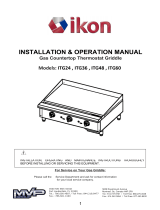
-
4 -
This griddle is Design Certified for installation on a non-combustible counter with 4” legs,
or combustible floor with 25” high stand.
INSTALLATION CLEARANCES
COMBUSTIBLE CONSTRUCTION NON-COMBUSTIBLE CONSTRUCTION
Back: 6” 0”
Right 6” 0”
Left Side 6” 0”
INSTALLATION CODES AND STANDARDS
The griddle must be installed in accordance with:
In the United States of America:
1. State and local codes.
2. National Fuel Gas Code, ANSI-Z223.1/NFPA #54 (latest edition). This shall include but
not be limited to: NFPA #54 Section 10.3.5.2 for Venting. Copies may be obtained
from The American Gas Association Accredited Standards Committee Z223, @ 400
N. Capital St. NW, Washington, DC 20001 or the Secretary Standards Council, NFPA,
1 Batterymarch Park Quincy, MA 02169-7471
NOTE: In the Commonwealth of Massachusetts
All gas appliances vented through a ventilation hood or exhaust system equipped with
a damper or with a power means of exhaust shall comply with 248 CMR.
3. NFPA Standard # 96 Vapor Removal from Cooking Equipment, latest edition, available
from the National Fire Protection Association, Batterymarch Park, Quincy, MA 02269.
In Canada:
1. Local codes.
2. CAN/CSA-B149.1 Natural Gas Installation (latest edition)
3. CAN/CSA-B149.2 Propane Installation Code (latest edition), available from the
Canadian Gas Association, 178 Rexdale Blvd., Etobicoke, Ontario, Canada M9W 1R3
GRIDDLES MOUNTED ON STANDS WITH CASTERS
Griddles mounted on stands with casters
must use a flexible connector (not supplied) that
complies with the Standard for Connectors for Movable
Gas Appliances ANSI Z21.69•CSA6.16, and a quick-
disconnect device that complies with Gas Fuel, ANSI
Z21.3•CSA6.9. In addition, adequate means must be
provided to limit movement of the appliance without
depending on the connector and the quick-disconnect
device (or its associated piping) to limit appliance
movement. Attach the restraining device at the rear of
the griddle as shown in Fig. 3.
Fig. 3.
If disconnection of the restraint is necessary, turn off the gas supply before
disconnecting. Reconnect the restraint prior to turning the gas supply on and returning
the griddle to its installation position.
















